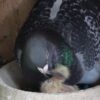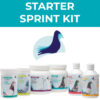
Breeding Success Enhancing Fertility in Racing Pigeons
Breeding season is one of the most critical periods for pigeon fanciers. Success during this phase determines the quality, health, and potential of the next generation of racing champions. Yet, many pigeon enthusiasts face challenges with fertility, hatch rates, and overall breeding performance. If you’re looking to enhance fertility in racing pigeons, you’re in the right place. This comprehensive guide will walk you through proven strategies, with a special focus on conditioning and fertility supplements, to ensure you get the best results from your breeding pairs.
Why Fertility Matters in Racing Pigeons
The quality of your racing loft begins with breeding. Strong, fertile parents produce robust offspring that are more likely to perform well in training and racing. A poor breeding season can set your loft back an entire year. Ensuring high fertility means fewer wasted eggs, healthier squabs, and better genetic transfer of traits such as speed, stamina, and intelligence.
Common Fertility Challenges in Racing Pigeons
Despite the best efforts, many fanciers encounter fertility problems. These include:
- Low egg production: Hens fail to lay or produce fewer eggs.
- Infertile eggs: Eggs that fail to develop despite being laid.
- Poor hatch rates: Embryos fail to fully develop or hatch.
- Weak squabs: Chicks that hatch weak, underweight, or with deformities.
These issues often stem from nutritional imbalances, poor conditioning, environmental stressors, or underlying health problems.
The Role of Conditioning Before Breeding
Proper conditioning sets the stage for a successful breeding season. Conditioning refers to preparing your birds physically and nutritionally for mating, egg-laying, and rearing young.
1. Timing the Breeding Cycle
Ensure your breeding season aligns with optimal environmental conditions—moderate temperatures and stable daylight hours. Birds bred in extreme conditions often exhibit lower fertility rates.
2. Health Checkups
Before pairing, assess the health of both cocks and hens. Check for signs of illness, parasites, or weakness. A healthy pair is more likely to breed successfully.
3. Adjusting the Diet
During the pre-breeding phase, begin transitioning your birds to a breeding-specific diet. This includes increased protein levels, essential fatty acids, and key vitamins and minerals such as Vitamin E, selenium, and calcium.
Fertility Supplements: A Game-Changer for Pigeon Breeding
Even the best diets can fall short when it comes to optimal fertility. This is where high-quality fertility supplements make a significant difference. These supplements are specially formulated to support reproductive health, improve egg quality, and boost hatch rates.
Key Ingredients to Look For:
- Vitamin E: Enhances reproductive hormone production and sperm quality.
- Selenium: Works with Vitamin E to improve fertility and reduce embryonic mortality.
- Amino Acids (e.g., Arginine, Methionine): Aid in egg formation and semen quality.
- Omega-3 Fatty Acids: Support hormone balance and healthy egg development.
- Folic Acid: Reduces the risk of deformities and boosts embryo development.
Recommended Supplement Protocol
- Start early: Begin supplementing at least 3–4 weeks before pairing.
- Daily dosing: Follow the manufacturer’s dosage for best results.
- Pair with proper diet: Supplements work best when used alongside a nutrient-dense breeding diet.
Environmental Factors That Influence Fertility
While nutrition and supplements play a huge role, your pigeons’ environment also impacts their reproductive success.
Lighting
Gradually increasing daylight hours helps stimulate the birds’ reproductive systems. Use soft artificial lighting in winter months to simulate spring conditions.
Nesting Conditions
Clean, safe, and private nesting boxes encourage mating and egg laying. Provide fresh nesting materials and monitor for signs of disturbance.
Stress Management
Minimize noise, handling, and sudden changes in the loft. Stress can suppress fertility and cause hens to stop laying.
Monitoring Fertility and Hatch Rates
Once your birds are paired and eggs are laid, it’s crucial to monitor fertility and development. Use a candling light around 7–10 days after eggs are laid to check for signs of embryo development. Infertile eggs should be removed to reduce clutter and stress in the nest.
Troubleshooting Breeding Problems
If you’ve done everything right and still face issues, consider the following:
- Age of breeders: Fertility can decline with age. Rotate older birds out of your breeding program.
- Inbreeding: Too much genetic similarity can lead to fertility issues. Introduce new bloodlines when needed.
- Undiagnosed illness: Respiratory infections, parasites, or underlying disease can reduce fertility. Consult a vet if problems persist.
Real-Life Results: Testimonials from the Loft
Many seasoned pigeon fanciers report significant improvements after incorporating fertility supplements into their regimen:
“I used to get a 60% hatch rate at best. After conditioning my birds and using fertility supplements with Vitamin E and selenium, I’ve been averaging over 85%.” — Johan M., Belgium
“I struggled with weak squabs until I started supplementing with amino acids and omega-3s. Now my young birds are thriving.” — Linda T., UK
Conclusion: Give Your Birds the Best Start
Enhancing fertility in racing pigeons is not just about increasing numbers—it’s about improving quality, health, and future performance. With proper conditioning and the right fertility supplements, you can ensure a strong foundation for your racing loft.
Breeding success starts long before the eggs are laid. Prepare early, supplement wisely, and give your pigeons every advantage to produce the next generation of winners.
Suggested Products:
- Fertility Boost Supplements (with Vitamin E, Selenium, Amino Acids)
- Breeding Season Conditioning Mixes
- Nutrient-Dense Grit and Minerals
Suggested Further Reading:
- “Top 5 Breeding Mistakes to Avoid in Racing Pigeons”
- “Creating a Year-Round Pigeon Supplement Schedule”
- “How to Improve Hatch Rates and Squab Health”


